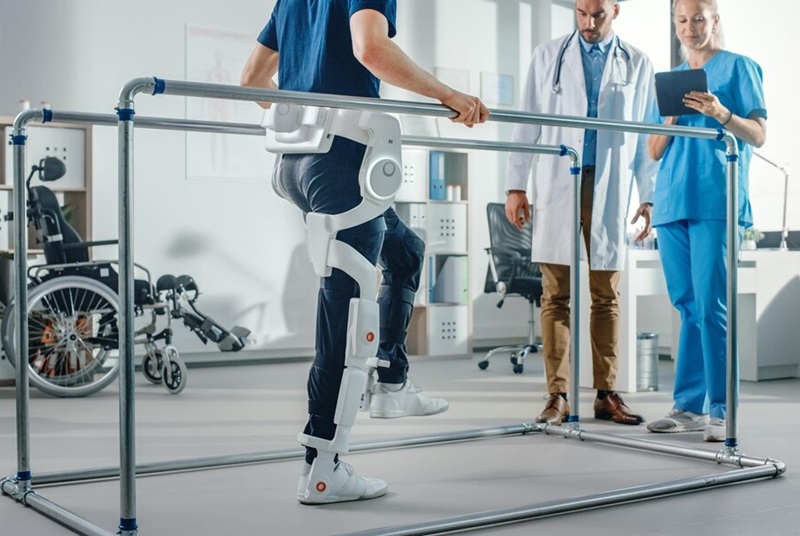Conventional knee replacement surgery, also known as traditional knee replacement, is a well-established procedure used to address various knee issues causing pain and limited mobility. During this surgery, the damaged part of the knee joint is replaced with a synthetic joint, made of metal and plastic components, with the main aim of reducing pain and restoring mobility.
The traditional approach involves a lengthy incision in the middle of the knee joint to access and visualize the affected area. The surgeon then removes damaged bone and cartilage from the femur, tibia, and patella before preparing the surfaces to receive the artificial joint components. Metal components are attached to the bone ends, with a plastic spacer inserted between them to enable smooth movement. The surgery usually takes about an hour, and patients are given spinal anesthesia.
Following traditional knee replacement, patients typically need a few days of hospitalization and 3-6 weeks of rehabilitation to regain strength and mobility in the knee joint. Rehabilitation includes physical therapy exercises to enhance flexibility and muscle strength in the treated area. During the initial recovery period, patients may use assistive devices such as crutches or walkers.
What is Robotic knee replacement surgery?
Robotic knee replacement, also referred to as robot-assisted knee replacement, is an advanced surgical technique for knee replacements. In this procedure, a robotic arm assists the surgeon in preparing bone surfaces and placing artificial joint components. During robotic knee replacement, the surgeon creates a 3D virtual model of the patient’s knee joint using advanced computer software. This model helps plan and customize the surgery according to the patient’s specific anatomy and needs.
The robotic arm follows the surgeon’s pre-planned movements, making precise cuts on the bone surface to prepare it for the implant. The surgeon has control over the robotic arm’s movements, allowing adjustments as needed throughout the procedure.
Once the bone surfaces are prepared, the surgeon places specially designed artificial joint components that fit the patient’s anatomy. The robotic arm assists in accurate and precise placement, ensuring optimal alignment and stability of the new joint. This innovative approach offers a more personalized and precise solution for knee replacement surgeries.
Differences Between Traditional and Robotic Knee Replacement Surgery:
1. Surgical Technique
Traditional knee replacement involves a long incision down the center of the knee to access the damaged joint. In contrast, robotic knee replacement in Mumbai uses a minimally invasive approach with smaller incisions. The surgeon utilizes a robotic arm to assist in preparing bone surfaces and placing artificial joint components.
2. Precision
Traditional surgery relies on the surgeon’s skill for precise cuts and measurements. Robotic knee replacement, however, employs advanced computer software and a robotic arm for more accurate cuts and measurements. This precision ensures optimal alignment and positioning of artificial joint components, potentially leading to better long-term outcomes.
3. Recovery Time
Robotic knee replacement may offer a shorter recovery time compared to traditional surgery. The smaller incisions result in less trauma to surrounding tissue, potentially leading to reduced pain and a quicker return to daily activities.
4. Cost
Generally, knee replacement surgeon in Thane is more expensive than the traditional approach. The use of advanced technology and specialized equipment contributes to the higher overall cost of the procedure.
5. Surgeon’s Experience
Performing robotic knee replacement in Mumbai requires specialized training, and not all surgeons are trained for this procedure. It may be available only at specific medical centers. Traditional knee replacement, being a well-established procedure, is more widely practiced, and most orthopedic surgeons are trained and experienced in performing it.
Advantages of Traditional Knee Replacement Surgery:
Traditional knee replacement surgery is a commonly performed procedure known for its reliability, thanks to the extensive training and experience of surgeons skilled in this method.
Compared to robotic knee replacement surgery, traditional knee replacement is generally more cost-effective, making it a financially accessible option for many patients. This procedure is widely available in most hospitals and medical centers, enhancing its accessibility.
One of the key advantages of traditional knee replacement is that it provides the surgeon with direct control, allowing them to customize the procedure according to the patient’s specific needs and circumstances.
Advantages of Robotic Knee Replacement Surgery:
Patients undergoing robotic knee replacement surgery often experience shorter hospital stays, leading to faster recovery times. The reduced need for physical therapy sessions contributes to a quicker return to daily activities.
Robotic assistance in knee replacement can result in less postoperative pain, stiffness, and discomfort for patients. This translates to a speedier recovery and a reduced reliance on pain medication.
The use of smaller incisions in the best knee replacement surgeon in Thane minimizes tissue damage and scarring, contributing to a faster recovery process.
The knee replacement surgeon in Thane has shown improved long-term outcomes and higher levels of patient satisfaction, underlining its effectiveness in enhancing overall surgical results.
Cost Comparison: Robotic vs. Traditional Knee Replacement
Knee replacement surgery is a prevalent procedure for individuals experiencing severe knee pain due to arthritis or other joint issues. While traditional knee replacement has been the standard treatment for decades, robotic-assisted surgery has emerged as a more advanced option, sparking comparisons in terms of efficacy and cost.
Cost breakdown:
Traditional Knee Replacement:
- Hospital charges: These vary depending on the hospital, city, and surgeon’s expertise, ranging from ₹1 lakh to ₹7 lakhs on average.
- Surgeon’s fees: These can range from ₹50,000 to ₹2 lakhs depending on experience and reputation.
- Implants: Costs can vary significantly depending on material and brand, ranging from ₹50,000 to ₹1 lakh per knee.
- Post-operative care: This includes physiotherapy sessions and medication, typically costing ₹20,000 to ₹50,000.
- Total cost: The estimated total cost for traditional knee replacement surgery in India can range from ₹2 lakhs to ₹12 lakhs.
Robotic Knee Replacement:
- Hospital charges: These are slightly higher than traditional surgery due to the use of the robotic system, averaging ₹2 lakhs to ₹8 lakhs.
- Surgeon’s fees: Fees may be higher due to the additional training and expertise required for robotic surgery, ranging from ₹75,000 to ₹3 lakhs.
- Implants: Costs are similar to traditional implants.
- Robot-assisted surgery fees: This additional cost varies depending on the hospital and robot system used, ranging from ₹1 lakh to ₹3 lakhs.
- Post-operative care: Similar to traditional surgery.
- Total cost: The estimated total cost for robotic knee replacement in Mumbai, India can range from ₹3.5 lakhs to ₹15 lakhs.
Factors influencing cost
- Hospital location and reputation: Costs are typically higher in metro cities and well-renowned hospitals.
- Surgeon’s experience and expertise: Experienced surgeons command higher fees.
- Type of implant used: Higher-quality and newer implants cost more.
- Robot system used: Different robotic systems have varying costs associated with their use.
- Insurance coverage: Some insurance plans might cover a portion of the surgery cost, but coverage varies depending on the plan.
Overall, the best knee replacement surgeon in Thane is generally more expensive than traditional surgery. However, the potential benefits, such as improved accuracy, quicker recovery time, and reduced complications, might offset the additional cost in the long run.
The Final Thought:
When it comes to robotic knee replacement in Mumbai, there are two main ways: using robots or doing it the regular way. The important thing to think about is the cost. Regular knee replacement is good for many people because it’s easy to get, the surgeon has more control, and it’s not too expensive. But if you want extra benefits like spending less time in the hospital, feeling less pain after surgery, and having better results in the long run, then the robotic way is an option, although it costs more.
So, when we compare the costs of a robot and regular knee replacement surgeon in Thane, we see that the decision isn’t just about money. It also depends on what each person wants, what their health needs are, and finding the right balance between cost and high-tech advantages. In the end, choosing between these two ways is a detailed decision affected by many things, making sure people can pick what’s best for their health and what they can afford.










